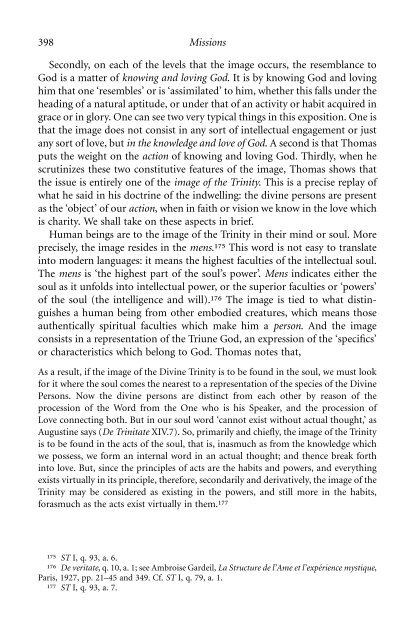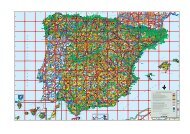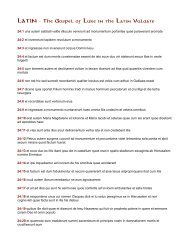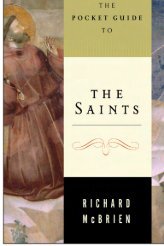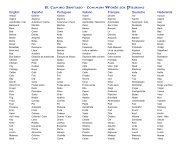- Page 3 and 4:
THE TRINITARIAN THEOLOGY OF SAINT T
- Page 5 and 6:
The Trinitarian Theology of Saint T
- Page 7 and 8:
Acknowledgements Many people have h
- Page 9 and 10:
Contents Abbreviations xi Introduct
- Page 11 and 12:
Contents ix 10. The Person of the H
- Page 13 and 14:
Abbreviations ACO Acta Conciliorum
- Page 15 and 16:
Introduction There is no subject wh
- Page 17 and 18:
Introduction 3 in his ‘Writing on
- Page 19 and 20:
Introduction 5 these questions that
- Page 21 and 22:
1 The Revelation of the Trinity Tri
- Page 23 and 24:
Revelation of the Trinity 9 heart o
- Page 25 and 26:
Revelation of the Trinity 11 begott
- Page 27 and 28:
Revelation of the Trinity 13 Testam
- Page 29 and 30:
Revelation of the Trinity 15 to san
- Page 31 and 32:
Revelation of the Trinity 17 So, in
- Page 33 and 34:
Speculative Trinitarian Theology 19
- Page 35 and 36:
Speculative Trinitarian Theology 21
- Page 37 and 38:
Speculative Trinitarian Theology 23
- Page 39 and 40:
Speculative Trinitarian Theology 25
- Page 41 and 42:
Speculative Trinitarian Theology 27
- Page 43 and 44:
Speculative Trinitarian Theology 29
- Page 45 and 46:
Speculative Trinitarian Theology 31
- Page 47 and 48:
Speculative Trinitarian Theology 33
- Page 49 and 50:
Speculative Trinitarian Theology 35
- Page 51 and 52:
The Treatise on the Triune God 37 I
- Page 53 and 54:
The Treatise on the Triune God 39 T
- Page 55 and 56:
The Treatise on the Triune God 41 T
- Page 57 and 58:
The Treatise on the Triune God 43 c
- Page 59 and 60:
The Treatise on the Triune God 45 i
- Page 61 and 62:
The Treatise on the Triune God 47 W
- Page 63 and 64:
The Treatise on the Triune God 49 D
- Page 65 and 66:
4 The Processions In the Summa Theo
- Page 67 and 68:
The Processions 53 Thomas adds, ‘
- Page 69 and 70:
The Processions 55 relations in our
- Page 71 and 72:
The Processions 57 examination show
- Page 73 and 74:
The Processions 59 whilst remaining
- Page 75 and 76:
The Processions 61 from non-being t
- Page 77 and 78:
The Processions 63 we Wnd here that
- Page 79 and 80:
The Processions 65 other. It is the
- Page 81 and 82:
The Processions 67 what is loved is
- Page 83 and 84:
The Processions 69 procession disti
- Page 85 and 86:
The Processions 71 So the distincti
- Page 87 and 88:
The Processions 73 really distinct
- Page 89 and 90:
The Processions 75 amongst which we
- Page 91 and 92:
The Processions 77 Thomas also uses
- Page 93 and 94:
Relations 79 God, but also a distin
- Page 95 and 96:
Relations 81 designate that which t
- Page 97 and 98:
Relations 83 invicem): it is in thi
- Page 99 and 100:
Relations 85 called relative, the n
- Page 101 and 102:
Relations 87 conceptual distinction
- Page 103 and 104:
Relations 89 with the divine person
- Page 105 and 106:
Relations 91 Following Aristotle an
- Page 107 and 108:
Relations 93 cannot be attributed t
- Page 109 and 110:
Relations 95 (2) But from the persp
- Page 111 and 112:
Relations 97 must also be real oppo
- Page 113 and 114:
Relations 99 principle of the intra
- Page 115 and 116:
Relations 101 procession of the Wor
- Page 117 and 118:
6 The Person St Thomas conceives th
- Page 119 and 120:
The Person 105 naturae individua su
- Page 121 and 122:
The Person 107 2. PERSON AND ANALOG
- Page 123 and 124:
The Person 109 Thus, one attributes
- Page 125 and 126:
The Person 111 St Thomas shows hims
- Page 127 and 128:
The Person 113 in God when he speak
- Page 129 and 130:
The Person 115 before giving the ei
- Page 131 and 132:
The Person 117 subsistens in natura
- Page 133 and 134:
The Person 119 back to God alone, a
- Page 135 and 136:
The Person 121 reality, relation is
- Page 137 and 138:
The Person 123 St Thomas finds this
- Page 139 and 140:
The Person 125 to us to have graspe
- Page 141 and 142:
The Person 127 the divine absolute,
- Page 143 and 144:
Trinitarian Monotheism 129 Faith ac
- Page 145 and 146:
Trinitarian Monotheism 131 already
- Page 147 and 148:
Trinitarian Monotheism 133 When one
- Page 149 and 150:
Trinitarian Monotheism 135 Church (
- Page 151 and 152:
Trinitarian Monotheism 137 meaning
- Page 153 and 154:
Trinitarian Monotheism 139 In the S
- Page 155 and 156:
Trinitarian Monotheism 141 The nume
- Page 157 and 158:
Trinitarian Monotheism 143 One can
- Page 159 and 160:
Trinitarian Monotheism 145 What mak
- Page 161 and 162:
Trinitarian Monotheism 147 characte
- Page 163 and 164:
Trinitarian Monotheism 149 Thomas r
- Page 165 and 166:
8 The Person of the Father Once he
- Page 167 and 168:
The Person of the Father 153 1. THE
- Page 169 and 170:
The Person of the Father 155 consti
- Page 171 and 172:
The Person of the Father 157 patern
- Page 173 and 174:
The Person of the Father 159 word a
- Page 175 and 176:
The Person of the Father 161 God in
- Page 177 and 178:
The Person of the Father 163 The th
- Page 179 and 180:
The Person of the Father 165 the pe
- Page 181 and 182:
The Person of the Father 167 the on
- Page 183 and 184:
The Person of the Father 169 procee
- Page 185 and 186:
The Person of the Father 171 the Fa
- Page 187 and 188:
The Person of the Father 173 St Tho
- Page 189 and 190:
The Person of the Father 175 appear
- Page 191 and 192:
The Person of the Son 177 personali
- Page 193 and 194:
The Person of the Son 179 the proce
- Page 195 and 196:
The Person of the Son 181 people co
- Page 197 and 198:
The Person of the Son 183 eVectivel
- Page 199 and 200:
The Person of the Son 185 accident
- Page 201 and 202:
The Person of the Son 187 . To be k
- Page 203 and 204:
The Person of the Son 189 Thomas re
- Page 205 and 206:
The Person of the Son 191 are funda
- Page 207 and 208:
The Person of the Son 193 One can o
- Page 209 and 210:
The Person of the Son 195 work with
- Page 211 and 212:
The Person of the Son 197 Son, and
- Page 213 and 214:
The Person of the Son 199 the divin
- Page 215 and 216:
The Person of the Son 201 6. THE WO
- Page 217 and 218:
The Person of the Son 203 faith Xow
- Page 219 and 220:
The Person of the Son 205 which Tho
- Page 221 and 222:
The Person of the Son 207 prays, Th
- Page 223 and 224:
The Person of the Son 209 foregroun
- Page 225 and 226:
The Person of the Son 211 Trinitari
- Page 227 and 228:
The Person of the Son 213 this: the
- Page 229 and 230:
The Person of the Son 215 creates a
- Page 231 and 232:
The Person of the Son 217 humans ha
- Page 233 and 234:
10 The Person of the Holy Spirit Th
- Page 235 and 236:
The Person of the Holy Spirit 221 c
- Page 237 and 238:
The Person of the Holy Spirit 223 m
- Page 239 and 240:
The Person of the Holy Spirit 225 T
- Page 241 and 242:
The Person of the Holy Spirit 227 p
- Page 243 and 244:
The Person of the Holy Spirit 229 O
- Page 245 and 246:
The Person of the Holy Spirit 231 f
- Page 247 and 248:
The Person of the Holy Spirit 233 H
- Page 249 and 250:
The Person of the Holy Spirit 235 t
- Page 251 and 252:
The Person of the Holy Spirit 237 H
- Page 253 and 254:
The Person of the Holy Spirit 239 o
- Page 255 and 256:
The Person of the Holy Spirit 241 H
- Page 257 and 258:
The Person of the Holy Spirit 243 t
- Page 259 and 260:
The Person of the Holy Spirit 245 W
- Page 261 and 262:
The Person of the Holy Spirit 247 T
- Page 263 and 264:
The Person of the Holy Spirit 249 H
- Page 265 and 266:
The Person of the Holy Spirit 251 t
- Page 267 and 268:
The Person of the Holy Spirit 253 h
- Page 269 and 270:
The Person of the Holy Spirit 255 T
- Page 271 and 272:
The Person of the Holy Spirit 257 a
- Page 273 and 274:
The Person of the Holy Spirit 259 s
- Page 275 and 276:
The Person of the Holy Spirit 261 I
- Page 277 and 278:
The Person of the Holy Spirit 263 t
- Page 279 and 280:
The Person of the Holy Spirit 265 T
- Page 281 and 282:
The Person of the Holy Spirit 267 T
- Page 283 and 284:
11 The Holy Spirit Proceeds from th
- Page 285 and 286:
Procession of the Holy Spirit 271 f
- Page 287 and 288:
Procession of the Holy Spirit 273 p
- Page 289 and 290:
Procession of the Holy Spirit 275 s
- Page 291 and 292:
Procession of the Holy Spirit 277 h
- Page 293 and 294:
Procession of the Holy Spirit 279 i
- Page 295 and 296:
Procession of the Holy Spirit 281 t
- Page 297 and 298:
Procession of the Holy Spirit 283 N
- Page 299 and 300:
Procession of the Holy Spirit 285 5
- Page 301 and 302:
Procession of the Holy Spirit 287 H
- Page 303 and 304:
Procession of the Holy Spirit 289 T
- Page 305 and 306:
Procession of the Holy Spirit 291 a
- Page 307 and 308:
Procession of the Holy Spirit 293 T
- Page 309 and 310:
Procession of the Holy Spirit 295 t
- Page 311 and 312:
Procession of the Holy Spirit 297 I
- Page 313 and 314:
Reciprocal Interiority of the Divin
- Page 315 and 316:
Reciprocal Interiority of the Divin
- Page 317 and 318:
Reciprocal Interiority of the Divin
- Page 319 and 320:
Reciprocal Interiority of the Divin
- Page 321 and 322:
Reciprocal Interiority of the Divin
- Page 323 and 324:
Reciprocal Interiority of the Divin
- Page 325 and 326:
Reciprocal Interiority of the Divin
- Page 327 and 328:
Appropriation 313 the smokescreen o
- Page 329 and 330:
Appropriation 315 acknowledges that
- Page 331 and 332:
Appropriation 317 Son.17 At the sam
- Page 333 and 334:
Appropriation 319 and Hilary. One c
- Page 335 and 336:
Appropriation 321 about the Trinity
- Page 337 and 338:
Appropriation 323 certain order amo
- Page 339 and 340:
Appropriation 325 procession, linke
- Page 341 and 342:
Appropriation 327 for appropriation
- Page 343 and 344:
Appropriation 329 in creatures, so
- Page 345 and 346:
Appropriation 331 far as he is the
- Page 347 and 348:
Appropriation 333 connected to the
- Page 349 and 350:
Appropriation 335 distinction of th
- Page 351 and 352:
Appropriation 337 essential attribu
- Page 353 and 354:
Trinitarian Creation and Action 339
- Page 355 and 356:
Trinitarian Creation and Action 341
- Page 357 and 358:
Trinitarian Creation and Action 343
- Page 359 and 360:
Trinitarian Creation and Action 345
- Page 361 and 362: Trinitarian Creation and Action 347
- Page 363 and 364: Trinitarian Creation and Action 349
- Page 365 and 366: Trinitarian Creation and Action 351
- Page 367 and 368: Trinitarian Creation and Action 353
- Page 369 and 370: Trinitarian Creation and Action 355
- Page 371 and 372: Trinitarian Creation and Action 357
- Page 373 and 374: Trinitarian Creation and Action 359
- Page 375 and 376: Missions 361 magnetism and caused t
- Page 377 and 378: Missions 363 the Holy Spirit in Chr
- Page 379 and 380: Missions 365 This generic deWnition
- Page 381 and 382: Missions 367 In this analysis, the
- Page 383 and 384: Missions 369 earthly presence of th
- Page 385 and 386: Missions 371 sentbytheone(s)fromwho
- Page 387 and 388: Missions 373 (a) Initial ClariWcati
- Page 389 and 390: Missions 375 (b) The Seal of Son an
- Page 391 and 392: Missions 377 participation in his e
- Page 393 and 394: Missions 379 commence with it, the
- Page 395 and 396: Missions 381 an object’). Rather,
- Page 397 and 398: Missions 383 Now, ‘to possess’
- Page 399 and 400: Missions 385 As in his ‘Writing o
- Page 401 and 402: Missions 387 demanding task to comp
- Page 403 and 404: Missions 389 Spirit. The Son in tur
- Page 405 and 406: Missions 391 there are not diVerent
- Page 407 and 408: Missions 393 Along with his peers,
- Page 409 and 410: Missions 395 When his secretary and
- Page 411: Missions 397 The notion of the imag
- Page 415 and 416: Missions 401 But Thomas does not el
- Page 417 and 418: Missions 403 supernatural knowledge
- Page 419 and 420: Missions 405 After discussing the i
- Page 421 and 422: Missions 407 and (3) the disclosure
- Page 423 and 424: Missions 409 of a creature who is e
- Page 425 and 426: Missions 411 of this person. (2) Th
- Page 427 and 428: Conclusion The Summa’s Trinitaria
- Page 429 and 430: Conclusion 415 the reception of the
- Page 431 and 432: Conclusion 417 connection with the
- Page 433 and 434: elievers, both religious and secula
- Page 435 and 436: Bibliography 421 Bonaventure, Saint
- Page 437 and 438: Bibliography 423 —— On Truth, 3
- Page 439 and 440: Bibliography 425 —— Questions d
- Page 441 and 442: Bibliography 427 —— ‘Le trait
- Page 443 and 444: Bibliography 429 Morerod, Ch., ‘T
- Page 445 and 446: Bibliography 431 —— Trinity and
- Page 447 and 448: Abelard 22, 137-138, 141, 278, 313-
- Page 449 and 450: Saint Jerome 114, 133, 276 John of
- Page 451 and 452: Accident 54, 59, 82, 84-87, 91-95,
- Page 453 and 454: Love 8, 24, 37-38, 42, 62-74, 86, 8
- Page 455: REVELATION


